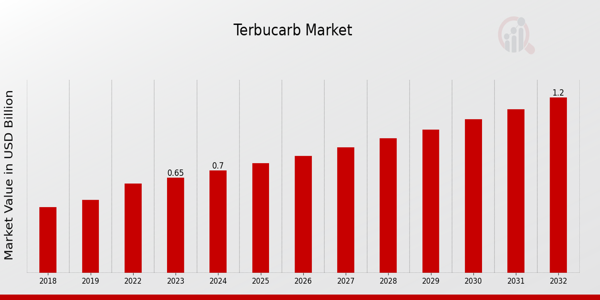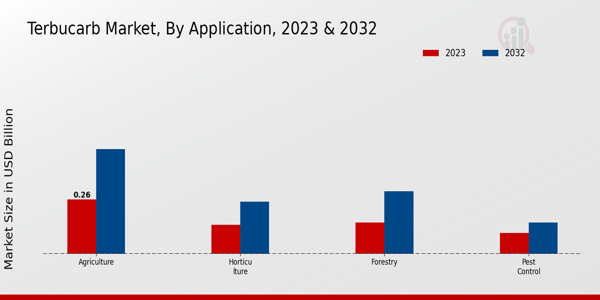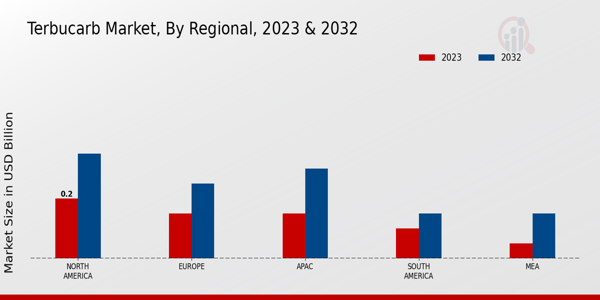Global Terbucarb Market Overview
The Terbucarb Market Size was estimated at 0.75 (USD Billion) in 2024. The Terbucarb Industry is expected to grow from 0.80 (USD Billion) in 2025 to 1.47 (USD Billion) by 2034. The Terbucarb Market CAGR (growth rate) is expected to be around 7.0% during the forecast period (2025 - 2034).
Key Terbucarb Market Trends Highlighted
The Terbucarb Market has experienced a number of key drivers including an increase in the awareness of food safety as well as an increase in the demand for effective crop protection methods. There is growing recognition among farmers on the necessity of proper agrochemical use to improve the quantity and quality of crops. This increasing scope on pest management in agriculture sector is advancing the market. Moreover, the expanding sector of organic farming increases the need of terbucarb and such agents for sustainable agriculture systems ensuring high agricultural yields. The spectrum within the market is attractive as new research is conducted to arrive at new formulations and application techniques that will enhance their effectiveness with minimal adverse environmental effects.
With continuous changes in agricultural practice, there is room for companies to come up with niche products designed for specific crops. In addition, the focus on integrated pest management systems opens up avenues for incorporating terbucarb into sophisticated agriculture practices. There is in addition the potential for further growth through expansion to emerging markets as they tend to have a great need for pest control measures. Recent years have shown a trend towards such developments in the agricultural sector which are more environmental friendly. There is a growing trend of bio-based and biodegradable materials, something that has led the sector to come up with solutions. Changes in regulatory policies are also taking place that will allow environmentally friendly chemicals to be used more freely and this is likely to support terbucarb’s market potential.
The trend here is moving towards the use of digital agriculture where not only do people monitor pest counts, but also reduce the volume of the agrochemicals used and these technologies are becoming popular. These sets of trends suggest that it is a period of transformation for the market as businesses respond to the changing demands from the consumers and the quest for sustainability. The market has a rapid expansion as it is constantly in the cycle of development, that which aims at efficiency and ecology.

Source: Primary Research, Secondary Research, MRFR Database and Analyst Review
Terbucarb Market Drivers
Growing Demand for Agricultural Inputs
The Terbucarb Market Industry is experiencing significant growth driven by the increasing demand for effective agricultural inputs. As the world population continues to rise, the necessity for enhanced agricultural productivity has become paramount. Farmers and agricultural businesses are seeking innovative solutions to combat pests and diseases that threaten crop yields. Terbucarb, with its effectiveness as a systematic pesticide, plays a crucial role in pest management strategies, ensuring that agricultural produce is of high quality and quantity.This demand is further fueled by the need for sustainable farming practices, as well as regulations emphasizing the use of environmentally friendly pesticides. In this context, Terbucarb offers a favorable profile, being less harmful to non-target species while ensuring effective pest control. The trend towards modern agricultural practices, technology-driven farming, and integrated pest management is expected to boost the Terbucarb Market further, attracting investments for research and development in agricultural chemicals.As producers strive to maximize their return on investment, Terbucarb stands out as a reliable option, driving its uptake across various agricultural segments.
Increased Focus on Sustainable Agriculture
A strong driver for the Terbucarb Market Industry is the heightened focus on sustainable agriculture practices. As the agricultural sector grapples with environmental concerns, there is a push toward using products that minimize ecological impact. Terbucarb's lower toxicity profile and effectiveness in pest control align with the growing demand for bio-based and environmentally friendly pesticides. This shift is coupled with regulatory support from governments promoting sustainable farming methods, which is expected to enhance the adoption of Terbucarb in various agricultural applications.
Expansion in Crop Varieties and Applications
The Terbucarb Market Industry is being driven by the expansion in crop varieties and applications. As farmers diversify their crop choices to meet consumer demand and adapt to changing climate conditions, the need for versatile and effective pest control solutions becomes evident. Terbucarb's adaptability across multiple crops enhances its appeal, ensuring that it meets the evolving requirements of modern agriculture.
Terbucarb Market Segment Insights
Terbucarb Market Application Insights
The Terbucarb Market within the Application segment is experiencing notable growth, reflecting the increasing demand across various sectors for effective pest control solutions. In 2023, the overall market is valued at 0.65 USD Billion and is expected to witness significant expansion by 2032. The segmentation within this market reveals the diverse applications of Terbucarb, prominently featuring Agriculture, which holds a considerable market value of 0.26 USD Billion in 2023, reflecting its majority holding position. This segment emphasizes the crucial role of Terbucarb in enhancing crop yield and managing pests efficiently. Horticulture, valued at 0.14 USD Billion in 2023, is also pivotal, focusing on maintaining plant health and productivity, which is vital given the increasing consumer shift toward quality horticultural products.Forestry shows a valued estimate of 0.15 USD Billion in 2023, highlighting its importance in managing forest ecosystems and protecting timber resources from pests and diseases, thereby ensuring sustainability in forestry practices. Lastly, the Pest Control segment, valued at 0.10 USD Billion in 2023, underscores a growing awareness and need for integrated pest management solutions both in agricultural and urban settings, critical for controlling pest populations effectively while ensuring environmental safety. The collective insights from these application segments reveal compelling opportunities, driven by escalating agricultural demands, the need for enhanced horticultural practices, sustainable forestry management, and the continuous evolution of pest control methodologies. As the market grows, the anticipated valuation rise demonstrates a robust increase in adoption rates of Terbucarb across these vital applications, with Agriculture leading the charge in terms of revenue. The overall market dynamics point toward an encouraging trend where the influence of Terbucarb in various applications is expected to strengthen, driven by technological advancements, increasing regulations focused on environmental sustainability, and the growing recognition of its effectiveness in pest management strategies across the sector.

Source: Primary Research, Secondary Research, MRFR Database and Analyst Review
Terbucarb Market Formulation Type Insights
The Terbucarb Market revenue is primarily driven by the segmentation based on Formulation Type, illustrating a diverse landscape that caters to various agricultural needs. In 2023, the market was valued at 0.65 billion USD, reflecting the growing adoption of Terbucarb formulations across different agricultural practices. The formulation type includes Granules, Liquid Concentrates, Emulsifiable Concentrates, and Wettable Powders that enhance usability and effectiveness in pest control. Granules are especially significant due to their ease of application and reduced risk of leaching, making them popular among farmers.Liquid Concentrates offer flexibility in application and efficiency in dissolving, attracting sectors that require precise dosing. Emulsifiable Concentrates are favored for their compatibility with other agrochemicals, providing a synergistic effect, while Wettable Powders maintain a strong presence because of their effectiveness in targeting specific pests in textured environments. As agricultural practices evolve, the demand for these formulations will likely see a considerable rise, reflecting the trends in the Terbucarb Market statistics, which are optimistic about continued market growth through 2032.This landscape presents ample opportunities, although challenges remain in terms of regulatory compliance and environmental concerns, driving innovation in formulation types and application methods.
Terbucarb Market End Use Insights
The Terbucarb Market is projected to experience robust growth, with a market value reaching 0.65 billion USD in 2023. The End Use segmentation plays a crucial role in this upward trend, encompassing key areas such as Crops, Turf Management, and Ornamentals. Each of these segments contributes significantly to the overall consumption of terbucarb, driven by the increasing need for effective pest control solutions in agriculture and horticulture. The Crops segment is essential for enhancing agricultural productivity and sustainability, while Turf Management holds its importance in maintaining healthy and aesthetically pleasing lawns and sports fields.The Ornamentals segment caters to the ornamental plant market, which has seen a surge in popularity due to urbanization and gardening trends. As the Terbucarb Market continues to evolve, the demand across these categories will likely shape market dynamics, influenced by factors such as technological advancements, regulatory developments, and changing consumer preferences. With market growth following a promising trajectory, ongoing innovations and growing awareness about pest management will further drive the expansion of the various end use sectors in the coming years.
Terbucarb Market Distribution Channel Insights
The Terbucarb Market, valued at 0.65 billion USD in 2023, is experiencing growth across various distribution channels, which significantly influences market dynamics. Online retail has gained substantial traction due to increasing consumer preference for digital purchasing, providing convenience and broader access to products. Conversely, offline retail remains a vital channel, serving as a traditional platform where customers can directly interact with products and receive personalized service. Agricultural cooperatives play a crucial role in the distribution of Terbucarb, as they not only bolster local agricultural access but also facilitate bulk purchasing, making them a significant contributor to market growth.The revenue from these distribution methods highlights a diversified approach that caters to various customer needs and preferences, driven by market trends focusing on accessibility and efficiency in supply chains. Market data suggests that with a majority holding, these channels will continue to support the unfolding landscape of the Terbucarb Market, which is projected to reach 1.2 billion USD by 2032, with a consistent growth trajectory.
Terbucarb Market Regional Insights
The Terbucarb Market is witnessing growth across various regions, with an overall market value of 0.65 USD Billion in 2023, projected to reach 1.2 USD Billion by 2032. In this landscape, North America holds a major share, valued at 0.2 USD Billion in 2023, and is expected to grow to 0.35 USD Billion by 2032, reflecting its significant demand and industrial applications. Europe follows closely, valued at 0.15 USD Billion in 2023 and anticipated to rise to 0.25 USD Billion by 2032, driven by regulatory support for sustainable agricultural practices.The APAC region, also noteworthy, stands at 0.15 USD Billion in 2023 with a potential increase to 0.3 USD Billion by 2032, showcasing a burgeoning market fueled by rising agricultural activities. In contrast, South America and MEA display smaller market shares, valued at 0.1 and 0.05 USD Billion in 2023, respectively, yet are expected to register growth, reflecting the increasing focus on agricultural productivity. The varying demand across these regions underlines the Terbucarb Market segmentation, highlighting North America's majority holding and the opportunities present in emerging markets like APAC and South America.The regional dynamics suggest growth drivers rooted in agricultural needs and environmental policies, while challenges include market access and competitive pricing.

Source: Primary Research, Secondary Research, MRFR Database and Analyst Review
Terbucarb Market Key Players and Competitive Insights
The Terbucarb Market is characterized by a robust competitive landscape where various players strive for market share through innovation, product development, and strategic initiatives. As an essential herbicide used in agriculture to control various weeds, terbucarb has garnered attention from manufacturers focused on enhancing agricultural productivity while managing environmental impacts. The market dynamics are influenced by factors such as regulatory changes, consumer demand for sustainable farming practices, and evolving agricultural technologies. In this competitive milieu, companies are engaged in extensive research and development to enhance the efficacy and safety profiles of terbucarb products, simultaneously exploring new applications to cater to a broader range of agricultural needs.Focusing on Sumitomo Chemical within the Terbucarb Market, the company exhibits a strong presence characterized by its commitment to innovation and sustainability. Leveraging its extensive research and development capabilities, Sumitomo Chemical has developed high-quality terbucarb formulations that meet the diverse needs of farmers across various regions. The company emphasizes product safety and environmental stewardship, ensuring that its offerings not only improve crop yields but also adhere to stringent regulatory standards. Furthermore, Sumitomo Chemical benefits from an established distribution network that enables effective market penetration, allowing them to maintain close relationships with end-users and stakeholders within the agricultural sector. This engagement fosters brand loyalty and positions the company favorably in a competitive environment where customer trust is paramount.FMC Corporation holds a significant position in the Terbucarb Market, recognized for its agricultural solutions that enhance crop production while addressing ecological challenges. The company has made considerable investments in developing advanced terbucarb products that are both effective against pests and relatively safe for the environment. FMC Corporation's dedication to innovation is evident in its continual efforts to improve product formulations, ensuring higher performance and efficiency. Additionally, the company benefits from strong research initiatives that cater to emerging agricultural trends, highlighting its adaptability in a fast-evolving market landscape. With a global footprint and a focus on sustainable agriculture, FMC Corporation is well-positioned to leverage growth opportunities within the terbucarb segment, solidifying its competitive advantage in delivering solutions that meet the evolving needs of farmers worldwide.
Key Companies in the Terbucarb Market Include
- Sumitomo Chemical
- FMC Corporation
- Dow AgroSciences
- Chemtura
- Syngenta
- BASF
- Bayer
- Nufarm
- Adama Agricultural Solutions
- Corteva Agriscience
- Nippon Soda
- Kehua Chemical
- Hanfeng Evergreen
- UPL Limited
- Eastman Chemical Company
Terbucarb Market Industry Developments
The Terbucarb Market has witnessed notable developments recently, particularly concerning major industry players such as Sumitomo Chemical, FMC Corporation, and Syngenta. Current affairs in the market indicate a growing emphasis on sustainable agricultural practices, prompting companies to innovate and improve product efficacy while reducing environmental impact. BASF and Bayer have been actively engaging in research aimed at enhancing the performance of Terbucarb formulations, focusing on pest resistance and crop yield improvement.In terms of mergers and acquisitions, Dow AgroSciences and Corteva Agriscience have been involved in strategic partnerships aiming to strengthen their positions in the agricultural sector. Additionally, Adama Agricultural Solutions has sought collaborations to enhance its product offerings within the Terbucarb segment. The growth of market valuation for firms like Nufarm and UPL Limited has significantly impacted the competitive landscape, driving technological advancements and increasing investments in research and development. These trends reflect an ongoing commitment by industry leaders to adapt to changing market dynamics and regulatory standards while striving for profitability and sustainability.
Terbucarb Market Segmentation Insights
- Terbucarb Market Application Outlook
- Agriculture
- Horticulture
- Forestry
- Pest Control
- Terbucarb Market Formulation Type Outlook
- Granules
- Liquid Concentrates
- Emulsifiable Concentrates
- Wettable Powders
- Terbucarb Market End Use Outlook
- Crops
- Turf Management
- Ornamentals
- Terbucarb Market Distribution Channel Outlook
- Online Retail
- Offline Retail
- Agricultural Cooperatives
- Terbucarb Market Regional Outlook
- North America
- Europe
- South America
- Asia Pacific
- Middle East and Africa
| Report Attribute/Metric |
Details |
| Market Size 2024 |
0.75 (USD Billion) |
| Market Size 2025 |
0.80 (USD Billion) |
| Market Size 2034 |
1.47 (USD Billion) |
| Compound Annual Growth Rate (CAGR) |
7.0% (2025 - 2034) |
| Report Coverage |
Revenue Forecast, Competitive Landscape, Growth Factors, and Trends |
| Base Year |
2024 |
| Market Forecast Period |
2025 - 2034 |
| Historical Data |
2020 - 2024 |
| Market Forecast Units |
USD Billion |
| Key Companies Profiled |
Sumitomo Chemical, FMC Corporation, Dow AgroSciences, Chemtura, Syngenta, BASF, Bayer, Nufarm, Adama Agricultural Solutions, Corteva Agriscience, Nippon Soda, Kehua Chemical, Hanfeng Evergreen, UPL Limited, Eastman Chemical Company |
| Segments Covered |
Application, Formulation Type, End Use, Distribution Channel, Regional |
| Key Market Opportunities |
Increased demand for sustainable agriculture, Growing preferences for eco-friendly pesticides, Expanding use in horticulture applications, Rising awareness of pest management solutions, Regulatory support for effective biopesticides |
| Key Market Dynamics |
Growing agricultural demand, Environmental regulations impact, Technological advancements in production, Competitive pricing strategies, Regional market expansions |
| Countries Covered |
North America, Europe, APAC, South America, MEA |
Frequently Asked Questions (FAQ) :
The Terbucarb Market is expected to be valued at 1.47 USD Billion by 2034.
The expected CAGR for the Terbucarb Market from 2025 to 2034 is 7.0%.
North America is projected to have the largest market share, valued at 0.35 USD Billion by 2034.
The Agriculture application of Terbucarb is expected to be valued at 0.5 USD Billion by 2034.
Major players in the Terbucarb Market include Sumitomo Chemical, FMC Corporation, Dow AgroSciences, and Syngenta.
The Pest Control application of Terbucarb is projected to be valued at 0.15 USD Billion by 2034.
The European region is expected to reach a market size of 0.25 USD Billion by 2034.
Key applications driving growth include Agriculture, Horticulture, Forestry, and Pest Control.
The Horticulture application of Terbucarb is expected to be valued at 0.25 USD Billion by 2034.
The APAC region is anticipated to grow to a market size of 0.3 USD Billion by 2034.

















